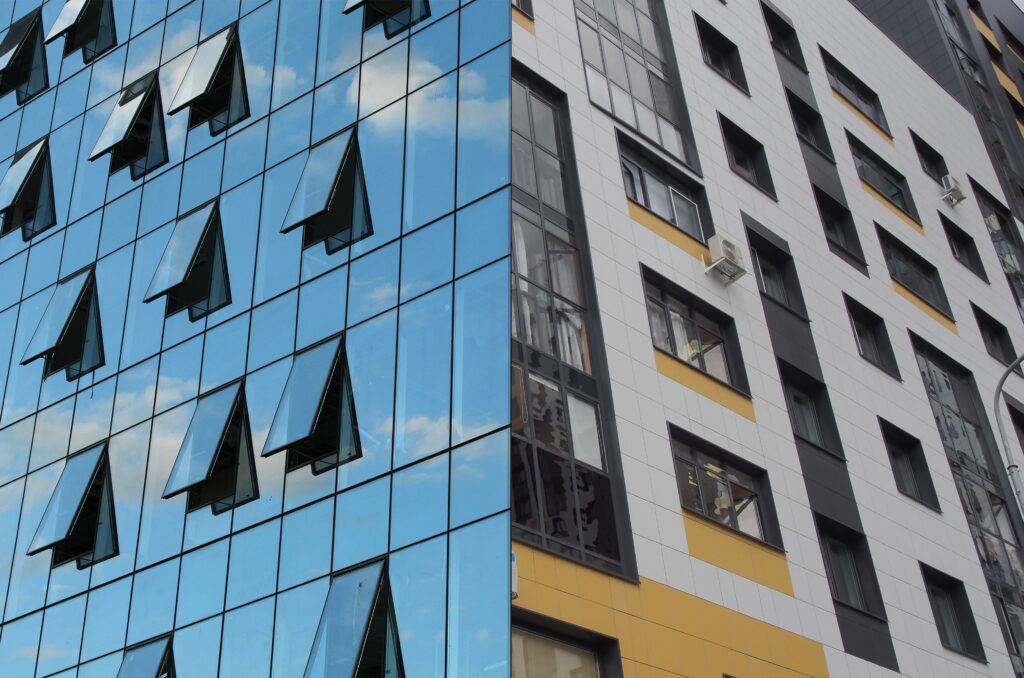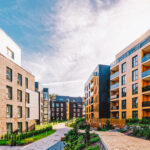The façade of a building can be considered the most essential part, its business card, and can define itself as the casing that separates the outside from the inside. In other words, like the skin of a construction. The ceramic ventilated façades – to be more precise in natural porcelain stoneware – are not only timeless, but are also highly sustainable and can be customised: from the colour to the kind of glazing required, right up to different special forms, nowadays all the design requirements can be met thanks to modern-day skills and technical knowledge.
You can choose from an extensive range of tile sizes and strips for the porcelain stoneware ventilated façades, to use as cladding. The main sizes used are, generally, rectangular (60×30 – 150×75 – 120×60 – 180×90 cm) or square (60×60 – 75×75 – 90×90 -120×120) although there are a wide range of options available.
Despite there being other kinds of cladding – like ventilated glass façades – ceramics are becoming increasingly popular, especially natural porcelain stoneware that continues to be the first choice when cladding a building, for a number of reasons. In particular:
- Natural porcelain stoneware is a solid, resistant material that allows you to clad a building – contributing to the enhancement of the architectural project – combining aesthetics, practicality and easy maintenance in a single solution.
- Natural porcelain stoneware is a ceramic material that can be easily cut even on site. This notably increases the chance of personalising the architectural project;
- Natural porcelain stoneware is ecological and the best material from an environmental point of view: indeed, it has a much longer life cycle and is highly resistant – it is probably one of the most resistant building materials in the world – it is not toxic, can’t catch fire, is impersonal and inert and, lastly, it is a material that requires very little maintenance throughout its life cycle.

Natural porcelain stoneware compared with ventilated glass façade: yet another reason to favour ceramic to clad buildings.
With regard to the ventilated glass façade – or rather, compared to the use of glass as a translucent and reflecting building material – that also has the quality of bringing personality to a building and providing an elegant, distinctive appearance, a ventilated ceramic façade has that “added touch”, in relation to certain intrinsic and unusual features of this material, that make it the ideal solution compared not only to glass but also to other materials such as marble, wood, natural stone and so on. One example is that natural porcelain stoneware cladding guarantees greater longevity and integrity of the building: something certainly worth bearing in mind.
If we close our eyes and try to imagine a futuristic, modern home – a house that emanates a sense of design and good taste – the image that stands out in our minds is that of a home clad in ventilated façade panels in natural porcelain stoneware, and not a ventilated glass façade. The reasons for this are very simple: the chromatism, consistency and modularity of the new designs in porcelain stoneware offer an even greater aesthetic possibility compared to the ventilated glass façade.
The ventilated porcelain stoneware façades with firmly settled details, offer finishings that meet the highest standards in quality. Natural porcelain stoneware and its different finishings are particularly well suited to achieving a unique, singular appearance when cladding buildings.
This façade cladding system on buildings – originally widespread in northern countries – is now highly regarded by most architects thanks also to its undisputed insulation qualities, that allow for a significant improvement in the building’s energy performance with regard to passive heating and cooling in buildings. Over time, with the porcelain stoneware ventilated façades, the acoustic insulation is also improved, contributing to the building’s certification. And this occurs even more so with ventilated glass façades, where certain kinds of glass are specifically designed to insulate the inside of a house or rooms from external noise.
Ventilated façade: ceramic or glass? Some final considerations on why ceramic is the best solution.
In order to take stock of what has been said, the ventilated ceramic façade and, more specifically, in natural porcelain stoneware, offers all the advantages that one can expect from a sustainable building material: produced with a natural raw material – ecological porcelain stoneware is a particular compact ceramic, achieved thanks to a blend of different natural raw materials like ceramic clay, feldspars, kaolin and sand that are finely ground to create a very fine powder, that is then compactly pressed without the use of glues and is then baked at extremely high temperatures of around 1150-1250 °C for 25-30 minutes – with no heavy metals or harmful additives, a ceramic façade offers insulation, is fire proof with excellent acoustic protection and is a good investment over the years, as it will retain its original beauty over time. Furthermore, the rear ventilation guarantees an internal balanced and healthy temperature and positively contributes to protecting the climate and environment.
The fact that the ceramic ventilated façade system is not just forward-thinking and well put together, but is also pleasant to look at, is clear from the numerous projects that have been produced by Imola Tecnica and which speak for themselves.
Projects that all have one thing in common: they convey an important message to the surrounding environment and do so with a strong expression that remains discreet. Furthermore, they convey the uniqueness of constructed ideas, in which sustainability plays an increasingly more important role.



